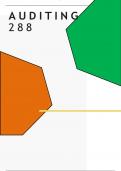Class notes
Best notes for Auditing 288 / 388(Whole year work)
- Course
- Institution
Comprehensive and well-organized Auditing 288 notes from Stellenbosch University, designed to help you excel in your studies. These notes provide detailed explanations of all key topics, ensuring a solid understanding of auditing principles and processes. With an exam-focused approach, they highlig...
[Show more]



